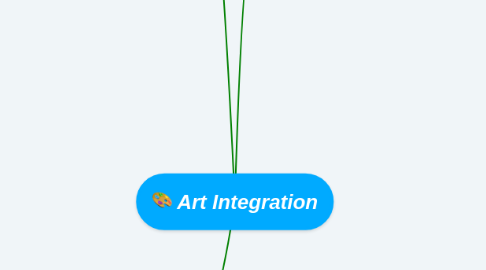
1. Chapter 2 - Arts Integration
1.1. Arts, Culture, and Identity
1.1.1. children can learn about many cultures and idividual children will feel that they and their identity are ackknowledged.
1.1.2. ex. teaching a song or dance, having an artwork hung in the classroom that was created by a child's relative, or family tree assignment
1.1.3. Culture can relate to the student's background/ethnicity, but it can also include subjects such as adoption or blended families.
1.2. Arts as Language
1.2.1. "Art is a mirror of reality" (Danto, 1981)
1.2.2. The arts provide humankind with modes for reflecting on, expressing, and documenting experiences, as well as providing a body of knowledge from which to draw upon.
1.2.3. Form of expression, communication, imagination, observation, perception, and thought.
1.2.4. Helps develop cognitive skills: listening, thinking, problem-solving, matching form to function, and decision-making.
1.3. Arts and Learning
1.3.1. Learning with the Arts
1.3.1.1. ex. Teaching a unit on the civil rights movement by playing songs of the civil rights movement.
1.3.2. Learning through the Arts
1.3.2.1. ex. having children act out the lifecycle of a flower or understanding DNA through re-creating it in a dance movement.
1.3.3. Learning about the Arts
1.3.3.1. ex. after reviewing paintings to study parallel lines and sets (with and through), students often are inspired to create their own paintings.
2. Jumpstarting Visual Literacy
2.1. Aesthetic Stages
2.1.1. Stage 1. Accountive Viewers: storytellers. (they use senses, memories, and personal associations.)
2.1.2. Stage 2: Constructive Viewers: set about actively building a framework for looking at works of art (they use their own perceptions, info about natural world, and values.
2.1.3. Stage 3: Classifying Viewers: adopt the analytical and critical stance of the art historian. (believes in categorization)
2.2. Things to CONSIDER regarding image selection
2.2.1. Accessibility
2.2.2. Captivation
2.2.3. Expressive Content
2.2.4. Narrative
2.2.5. Diversity
2.2.6. Realism
2.2.7. Media
2.2.8. Subjects
2.2.9. Sequences
2.2.10. Series/themes
2.3. Things to AVOID regarding image selection
2.3.1. Illustrations, photojournalism, cartoons, and advertisements--narrow range of interpretations.
2.3.2. Images depicting violence, specific political stances, specific religious imagery, nudity, overt sexuality/sensuality, or grotesque nature.
2.3.3. Abstractions/still lives
3. Chapter 3 - What Does It Mean to Be a Learner?
3.1. 10 Wishes for Children - pg.42
3.1.1. Wonder
3.1.2. Desire
3.1.3. Passion
3.1.4. Risk Taking
3.1.5. Confidence
3.1.6. Complexity
3.1.7. Engagement
3.1.8. Practicality
3.1.9. Ownership
3.1.10. Empathy
3.2. Intellectual Development, Mind-Set and Grit
3.2.1. Elenor Roosevelt: declares that the having of wonderful ideas is essentially a creative effort.
3.2.2. Jean Piaget: "intelligence is an adaptation...Life is a continuous creation of increasingly complex forms and a progressive balancing of these forms with the environment."
3.2.3. Angela Duckworth expands the notion of growth by adding "grit" into the mix. Grit qualities include:
3.2.3.1. 1. Goal-directedness (knowing where to go and how to get there)
3.2.3.2. 2. Motivation (having strong will to achieve identified goals)
3.2.3.3. 3. Self-control (avoiding distractions and focusing on the task at hand)
3.2.3.4. 4. Positive Mindset (embracing challenge and viewing failure as a learning opportunity)
3.2.4. ex. compose and notate a "kitchen piece--" create a short sound composition using objects found in the kitchen. GOAL: pushes students beyond their ordinary limits to create something out of an extraordinary situation.
3.3. "Translation through Representation"
3.3.1. Learning is a personal matter and varies for different children and proceeds best when childrn are actively engaged in their own leanring.
3.3.2. Metaphors! They :encourage us to discover relationships and how they might be articulated."
3.3.3. Artistic activity naturally encourages representation and the use of metaphors.
3.4. What Does it Mean to Be a Learner?
3.4.1. ex. using children's visual depeictions of metamorphpsis. Older students interpreting their art.
3.4.2. "Learning is like the wings of a bird or a butterfly" Metaphor!
3.4.3. engage students in thinking and working with their ideas concerning learning. This is emphasized by reviewing each other's ideas.
